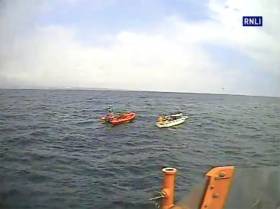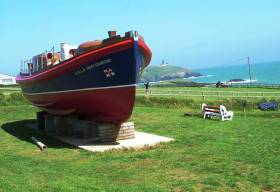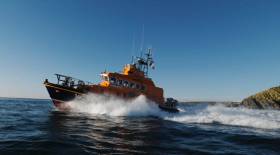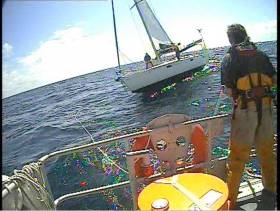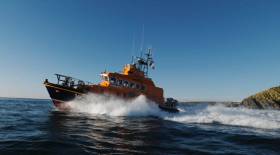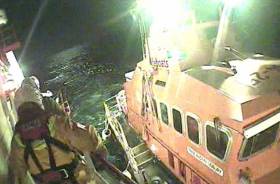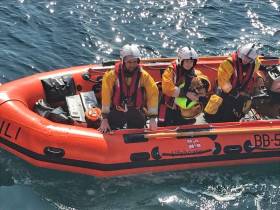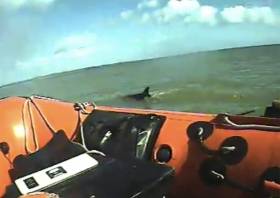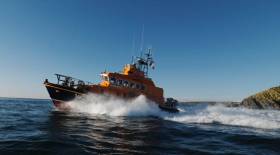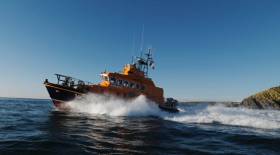Displaying items by tag: Ballycotton
East Cork Lifeboats Rescue Three From Sinking Vessel
#RNLI - Three men were rescued from their pleasure boat off an East Cork island on Thursday afternoon (26 July) when it began taking on water.
Ballycotton RNLI launched their all-weather lifeboat at around 1.40pm to to the scene east of Capel Island, where the men on board the 26ft pleasure boat had issued a Mayday to the Irish Coast Guard.
Youghal RNLI was also requested to launch their inshore lifeboat, while the coastguard’s Waterford-based helicopter Rescue 117 was also tasked.
Youghal was first on scene and placed two volunteer crew members onboard the boat with a salvage pump. Ballycotton RNLI and its crew arrived shortly after and transferred a larger salvage pump onto the vessel from their all-weather lifeboat.
The three casualties were transferred onto the Youghal lifeboat and brought ashore where they were assisted by Youghal Coast Guard. Ballycotton RNLI took the casualty vessel under tow and brought it ashore.
“This launch had the potential to be extremely serious for the casualties,” said Ballycotton RNLI coxswain Eolan Walsh, “but due to the collaboration with our colleagues at Youghal RNLI and the Irish Coast Guard, we had a safe outcome. We would like to wish the three men involved well following their ordeal.”
Famous Ballycotton Lifeboat Needs Volunteers
The East Cork village from where the lifeboat station crew carried out what is regarded as the most famous rescue in Irish lifeboat history, to the Daunt Rock Lightship off Cork Harbour, is in need of volunteers for its present-day crew, writes Tom MacSweeney.
That rescue was carried out aboard the historic Mary Stanford lifeboat, now preserved in the village as a commemorative memory of what that crew achieved on February 7, 1936.
Eighty-two years later, on next Monday week, February 19, as Afloat.ie reported here a meeting will be held in the village for all those interested in volunteering to help the lifeboat. The RNLI is looking for lifeboat crew members and volunteer fundraisers.
Mary Creedon, RNLI Community Fundraising Manager, has called on any volunteers who may be interested to “come along to the station on Tuesday, 19 February, at 7.30 p.m. to find out more. We are looking for anyone who is willing to offer some of their free time to join what I believe to be, one of the most exhilarating and rewarding voluntary services that is out there. Every volunteer receives first class training from the RNLI and learns new skills which can benefit them in many walks of life. Lifeboat crew members need to have a reasonable level of fitness, have good eyesight and not be colour blind. We are looking for a range of community lifesaving volunteers - shore crew play an essential role in the launch and recovery of the lifeboat when it goes on service and we need volunteers to help us fundraise and share our safety messages.”
Nineteen-year-old Sile Scanlon is one volunteer who joined the volunteer lifeboat crew after she herself was rescued. Sile explained: ‘A few years ago I was kayaking just off Ballycotton with three friends when the weather deteriorated and we got into difficulty. There was a big swell as a result and we were afraid that are our kayaks might capsize. We raised the alarm and made our way to the lighthouse where Ballycotton RNLI’s all-weather lifeboat came to our assistance.’
Sile is now two years on the lifeboat crew and loves being a volunteer.
“Growing up in Ballycotton I have always had a love for the sea and with my family so involved, the RNLI has always been close to my heart. I always wanted to join the crew but when I was rescued myself, I experienced first-hand the value of the charity’s community lifesaving work. Whether a volunteer is a seagoing crew member or is on the shore helping to prepare the lifeboat for launch or fundraising to make a rescue possible, their contribution really does makes a difference. I find it is also very satisfying to give back to your community and to be part of a great team,” she says.
Anyone who feels they have the time and commitment to volunteer for the charity which is on call 24 hours a day and 365 days a year, is invited to attend the meeting or to email their interest to: [email protected]
#RNLI - Ballycotton RNLI launched their all-weather lifeboat on Wednesday afternoon (9 August) to aid a yacht in difficulty some 84 miles south of the East Cork village.
Vencom, a Ker 39 with 10 people onboard, was returning from the Fastnet Race when it lost its rudder and was unable to steer.
The resulting support by Ballycotton RNLI saw the volunteer lifeboat crew on service for over 10 hours, eventually returning home to Ballycotton shortly after 11.30pm.
St Mary’s lifeboat from the Isles of Scilly was also requested to launch and was first to arrive on scene at 4.15pm, half an hour before the Ballycotton crew.
The St Mary’s volunteers put Vencom under tow and began to take the vessel back ashore to Scilly.
However, the yacht began manoeuvring violently while under tow and was unable to hold a straight line behind the lifeboat, requiring assistance from the Ballycotton lifeboat.
The Cork crew agreed to pass a casualty drogue to the yacht, which enabled it to remain in a towable position and under control.
Once confirmed that the casualty vessel and St Mary’s lifeboat were safe and in a stable towing position, the Ballycotton lifeboat returned to station.
Commenting on the callout, Ballycotton RNLI coxswain Eolan Walsh said: “This was the furthest offshore rescue that I personally have ever been requested to, and it was a pleasure to be able to assist the crew of the Vencom.
“We would like to commend both the crew members onboard the yacht who were all wearing suitable lifejackets and also thank the crew on board the St Mary’s lifeboat for their efforts in ensuring a positive outcome for all involved.”
Walsh added: “I would also like to thank my volunteer crew who, despite a very long and tiring launch, remained focussed on bringing everyone home safely.”
#RNLI - Ballycotton RNLI launched their all-weather lifeboat yesterday morning (Saturday 22 July) following a request from Falmouth coastguard, who reported the activation of an emergency beacon some 60 miles off the Cork coast.
The three-person crew of a 40ft yacht had activated their EPIRB as the vessel was taking on water and needed immediate assistance.
Ballycotton’s lifeboat crew launched at at 9.28am — and resulting tow saw the lifeboat crew on service for 14 hours, eventually bringing the vessel and its crew into Crosshaven last night.
Sennen Cove lifeboat and the coastguard helicopter from Newquay were also dispatched to the scene, but were stood down with the arrival of Ballycotton RNLI and the Irish Coast Guard helicopter Rescue 117.
Once it was confirmed that the water was receding, Rescue 117 was stood down and Ballycotton RNLI established a tow with the vessel to bring it safely to Cork Harbour.
With the lifeboat being such a long distance off shore, radio coverage was challenging. The vessel Ocean Spey, which was on standby at the gas fields halfway between the Cork coast and the yacht, helped by relaying comms between the lifeboat and the coastguard.
“This was one of the longest callouts for our lifeboat crew as they spent nearly a day at sea,” said Ballycotton RNLI coxswain Eolan Walsh.
“Many agencies and vessels played a part in the successful resolution of this and thankfully nobody was injured with both crew and yacht been brought safely to shore.
“I want to thank my volunteer lifeboat crew who despite the challenging conditions were focused on bringing everyone home safely.”
Ballycotton Lifeboat Rescues Kitesurfer In Difficulty
#RNLI - Ballycotton RNLI launched at around 10.30am yesterday morning (Monday 26 June) to aid a kitesurfer who had got into difficulty in Ballycotton Bay, Co Cork.
The all-weather lifeboat remained on standby as the inshore lifeboat headed to the casualty’s reported location.
Weather conditions at the time were described as mild with light winds.
Once on scene, the lifeboat crew brought the kitesurfer on board for medical assessment. When it was determined that no further medical attention was needed, the casualty was brought safely back to shore.
Speaking following the callout, Ballycotton RNLI coxswain Eolan Walsh said: “We would like to commend the numerous members of the public who raised the alarm this morning for their vigilance. Their quick thinking contributed to a positive outcome for all involved.
“We reminded everyone taking to the sea this summer to respect the water no matter what their activity.”
Ballycotton RNLI launched in the early hours of this morning (Wednesday 10 May) to assist in the medical evacuation of a fisherman 20 miles south of Ballycotton Lighthouse.
The volunteer lifeboat crew was requested to launch their all-weather lifeboat by the Irish Coast Guard at 12.33am.
The lifeboat under Coxswain Eolan Walsh and with six crew members onboard launched to meet the fishing vessel which had five crew members onboard and was making its way to Ballycotton.
The Irish Coast Guard helicopter Rescue 117 from Waterford was also tasked.
Weather conditions at the time were described as good with a easterly Force 1-2 wind blowing.
Arriving at 1.20am, two lifeboat crew members were immediately put on board the casualty’s vessel where they proceeded to assess the man and administer casualty care.
The man was then transferred onto the lifeboat and brought back to Ballycotton where he was transferred into care of a waiting ambulance crew on the pier.
Speaking following the call out, Ballycotton RNLI Coxswain Eolan Walsh said: ‘We were glad the fishermen, all of whom were wearing lifejackets, were able to raise the alarm when one of their crew members began to feel unwell and required medical assistance. We would like to wish the man a speedy recovery following his ordeal early this morning.
‘As we approach the summer months, we would remind anyone taking to the sea to always carry a means of calling for help or signalling should you need assistance. It is also important to let someone on the shore know when you set sail and when you are due back.’
Ballycotton Lifeboat Rescues Dog Stranded On Cliff
#RNLI - Ballycotton RNLI was launched yesterday morning (Wednesday 19 April) to rescue a dog that was stranded on the side of a cliff near the East Cork village.
The all-weather and inshore lifeboats were both launched to an area known locally as the Cradle and Table, less than one mile west of Ballycotton Bay, after a member of the public alerted the volunteer lifeboat crew.
Weather conditions were reportedly calm with some light winds.
The dog was brought onboard the inshore lifeboat by the crew members and, once safe, he was transferred to the all-weather lifeboat and returned to his owners onshore.
Speaking following the callout, Ballycotton RNLI mechanic Maire Scanlon said: “We are delighted that this launch had such a positive outcome.
“Locally the dog is known as Paudie, and we are delighted to report he has since been assessed by a local and vet and is recovering well.
“We would also like to thank our colleagues from the Ballycotton Coast Guard unit who were also on scene to lend their assistance.”
Ballycotton Lifeboat Launches To Stranded Dolphin
#RNLI - Ballycotton RNLI launched around 1pm yesterday afternoon (Thursday 29 September) to aid a dolphin stranded in shallow water on Silver Strand beach near the East Cork village.
A member of the public who was on scene had tried to assist the dolphin back to sea, but when they were unable to do so they alerted the Ballycotton lifeboat.
Ballycotton’s inshore lifeboat and its volunteer crew were quickly on scene, with the all-weather lifeboat on standby due to the offshore breeze and calm weather conditions.
Upon arrival, coxswain Eolan Walsh entered the water, guided the marine mammal into deeper water and shepherded it back out to sea.
Speaking after the callout, Walsh said: “Similar to a previous launch last summer, this dolphin appeared to be quite young and may have been separated from its pod.
“We would like to commend the member of the public who assisted the dolphin initially. We were happy to help and bring the dolphin into deeper waters.”
Injured Fisherman Rescued By Ballycotton Lifeboat
#RNLI - Ballycotton RNLI came to the rescue of an injured fisherman who got his hand cut when attempting to untangle a net this morning (Friday 26 August).
The volunteer crew launched their all-weather and inshore lifeboats at 8.30am after the man, who was fishing at Ardnahinch in East Cork, raised the alarm.
The fisherman had been attempting to untangle a net which had got caught in his boat’s propeller when he got into difficulty.
The all-weather lifeboat, under coxswain Eolan Walsh and with five crew members onboard, launched along with the station’s boarding boat with two crew members. Weather conditions at the time were described as good with moderate Force 3-4 south-westerly winds.
The lifeboats made their way to scene 1.5 nautical miles from Ballycotton, where the smaller boarding boat was able to gain good access to the casualty vessel.
A crew member went onboard the boat and assessed the fisherman before applying a bandage to his hand. The man was then transferred to the all-weather lifeboat and given further casualty care by crew member Claire McCarthy, who is also a nurse. The casualty was treated with no further medical assistance required.
As the all-weather lifeboat proceeded to bring the fisherman safely back to shore, the crew on the boarding boat worked to set up a towline before bringing the fisherman’s boat back to Ballycotton.
Speaking following the callout, Walsh said: "The fisherman did the right thing this morning and called for assistance when he found himself in difficulty and we would like to wish him a speedy recovery following his injury.
"We would encourage everyone whether they are using the sea for work or leisure to always respect the water. Always wear a lifejacket and carry a means of calling for helping and know how to use it should you get into trouble."
Ballycotton Lifeboat Rescues Child Adrift On Inflatable Dinghy
#RNLI - Ballycotton RNLI rescued a child yesterday evening (Thursday 4 August) after an offshore breeze pulled her inflatable dinghy out to sea.
Ballycotton’s all-weather lifeboat, under coxswain Eolan Walsh, was launched around 5.30pm after the nine-year-old girl got into difficulty off Ardnahinch beach.
Valentia Coast Guard was quickly alerted and then requested the volunteer crew members from Ballycotton and Youghal RNLI to launch their all-weather and inshore lifeboats.
Although weather conditions were calm, an offshore breeze blew the inflatable dinghy out to sea with the girl clinging on.
Ballycotton's inshore boarding boat was first to arrive on scene, shortly followed by the all-weather lifeboat.
The girl was brought onboard the inshore lifeboat where she was assessed and found to be safe and well but in a distressed state. She was assisted by the crew member and brought back safely to her parents on the beach.
"This was a frightening experience for the young girl and her family and we would like to wish them all well following their ordeal," said Walsh after the callout.
"Thankfully, the alarm was raised quickly and the casualty was wearing a suitable buoyancy aid which attributed to a positive outcome."
Walsh added that "while the coast is a great place for young people and families to enjoy, we would remind everyone to respect the water, to understand the risks and to stay safe.
"When using a dinghy, always make sure you wear an appropriate lifejacket or buoyancy aid; always carry a means of calling or signalling for help.
"Check the weather forecasts and tide times before you go and if on your own, tell someone about your plans – where you intend to go and when you expect to return, and know how to contact the coastguard."


























